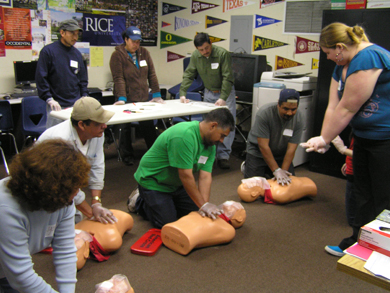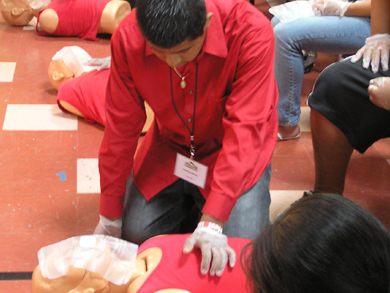March marks the one-year anniversary of the devastating earthquake and tsunami that killed tens of thousands of Japanese – and put California emergency officials on high alert. Since that time, Puente has been busy making sure that South Coast residents are prepared for “the big one” when it hits – whether flood or earthquake.
In the pre-dawn hours of March 11, 2011, San Mateo County emergency officials watched the devastating tsunami on the Pacific Rim and issued an evacuation order for homes in low-lying coastal zones. Their first call to the South Coast at 4:45 AM was to Puente executive director, Kerry Lobel.
Ultimately, the tsunami produced no discernible crisis on the South Coast. Far more dangerous was the confusion and panic that morning as people woke up to television footage of a towering wall of water that ripped, Godzilla-like, through Miyagi Prefecture. Officials eventually canceled the evacuation notice, but many Latino residents – especially those living in farm worker housing along Highway 1 – had already fled to higher ground above La Honda, with improvised emergency kits. The county’s automated messages were in English and most people weren’t signed up to receive them. Puente staffers came to the office at 5 a.m. and made dozens of personal phone calls to Spanish-speaking families, but reached and evacuated less than two dozen of them.
“There was a lot of misinformation, and families weren’t prepared to act in the case of emergency,” said Rita Mancera, Program Director for Puente.
Puente helped Red Cross volunteers staff the shelter at Pescadero High School for 100 people – only a fraction of evacuees stayed in town. A group of CERT-trained Puente youth stepped in because the Red Cross didn’t have bilingual staff members to translate.
Mancera ticks off some of the other problems that arose that day: “The Red Cross shelter was not stocked with food or water or diapers. CERT-trained volunteers were not activated.”
The South Coast Citizens Corps Council (SC4), along with Puente, have met along with San Mateo County officials to identify several areas of improvement in a debriefing after the tsunami, and Puente is working with the Red Cross and county emergency officials to ensure that communication gaps are filled next time around.
After the tsunami, Puente obtained a $55,000 grant from the Silicon Valley Community Foundation to train 60 key community members including business and school leaders, ranch and nursery foreman, and others in CPR and First Aid (Another 40 Puente youth and staff members also have First Aid and CERT training). Trainings were held in Pescadero, La Honda and at Moon Ridge/Main Street Apartments in Half Moon Bay.
Pescadero resident (and Puente staff member) Veronica Ortega was among those that received the training.. On March 11, she and her husband awoke to a panicked phone call from her aunt, who told her to evacuate. They packed their two young children into their car at the crack of dawn and drove to Skyline Boulevard. “We knew that Pescadero is an area that floods,” she said (Much of Pescadero is in a flood zone, although few of its residents would have been affected by a tsunami) “We knew if something happened we were not going to be safe.”
At the time, the family didn’t even have an emergency kit set aside. Now Ortega says she feels much more confident.
In real emergencies, South Coast residents have learned to take care of their own. But there is a need for a clear plan for the whole community, according to Peter Chupity, an amateur radio operator who lives in La Honda. He would also like to see more volunteers step up to learn how to operate ham radios, and practice using them. It may be the only way to reach the Sheriff’s Office in a disaster.
“We pretty much only have a couple of routes in and out of the area. If we have major weather, slides, or trees down, the roads can be closed for a long period of time,” he explained. “We don’t have gas lines or water lines, so when the power goes out it also means we’re out of water, too.”
Puente, along with its partners at SC4, are meeting monthly to put together such a plan. Fortunately, for our community, March 11 was not a real emergency, but rather a wake-up all to take more action.
For more information, contact Alicia Vega at avega@mypuente.org— or 650.879.1691 ext. 114.



